

First Class Web. Chinese Calligraphy: Brush Pen, Paper, Ink Stick and Slab. General Introduction In China calligraphy occupies a distinguished position in the field of traditional art.
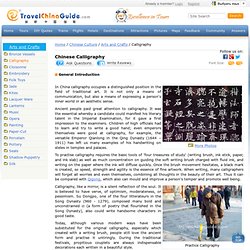
It is not only a means of communication, but also a means of expressing a person's inner world in an aesthetic sense. Ancient people paid great attention to calligraphy. It was the essential whereby a candidate could manifest his literary talent in the Imperial Examination, for it gave a first impression to the examiners. Children of high officials had to learn and try to write a good hand; even emperors themselves were good at calligraphy, for example, the versatile Emperor Qianlong in the Qing Dynasty (1644 – 1911) has left us many examples of his handwriting on steles in temples and palaces. To practise calligraphy requires the basic tools of 'four treasures of study' (writing brush, ink stick, paper, and ink slab) as well as much concentration on guiding the soft writing brush charged with fluid ink, and writing on the paper where the ink will diffuse quickly.
History. Chinese%20Calligraphy. Chinese Cooking Method, Cooking Method in China. Chinese cooking is renowned throughout the world.
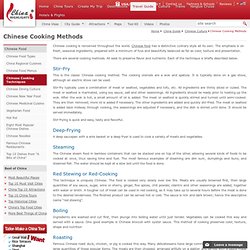
Chinese food has a distinctive culinary style all its own. The emphasis is on fresh, seasonal ingredients, prepared with a minimum of fuss and beautifully balanced as far as color, texture and presentation. There are several cooking methods. All seek to preserve flavor and nutrients. Each of the technique is briefly described below. Chinese Food/Chinese Cuisine, Chinese Food Culture, Chinese Food Menus. Food has a special meaning to the Chinese people.
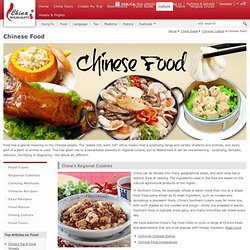
The "waste not, want not" ethos means that a surprising range and variety of plants and animals, and every part of a plant or animal is used. This has given rise to a remarkable diversity in regional cuisine, but to Westerners it can be overwhelming - surprising, fantastic, delicious, horrifying or disgusting - but above all, different. China's Regional Cuisines China can be divided into many geographical areas, and each area has a distinct style of cooking. Bound to Be Beautiful: Foot Binding in Ancient China. June 4, 2005–August 28, 2005 Bound to Be Beautiful: Footbinding in Ancient China is a traveling exhibit from the collection of John K.
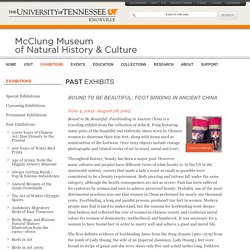
Fong featuring many pairs of the beautiful and elaborate shoes worn by Chinese women to showcase their tiny feet, along with items used in construction of the footwear. Over sixty objects include vintage photographs and related works of art in wood, metal and ivory. Throughout history, beauty has been a major goal.
However, many cultures and peoples have different views of what beauty is. Foot binding. As of July 1, 2013 ThinkQuest has been discontinued.

We would like to thank everyone for being a part of the ThinkQuest global community: Students - For your limitless creativity and innovation, which inspires us all. Teachers - For your passion in guiding students on their quest. Partners - For your unwavering support and evangelism. The Legend of Hua Mulan. According to Chinese legend, there was a female warrior named Hua Mulan who joined the army to fight in place of her father.

Mulan was reputed to be a very brave woman who disguised herself as a man and fought in combat for 12 years. She has become an iconic heroine in Chinese and western cultures alike. The legend of Mulan is similar to several other female characters that dressed as men to fight in battle. The legend of Hua Mulan. The legend of Hua Mulan The name Hua Mulan has been synonymous with the word "heroine" for hundreds of years in Chinese society and culture.
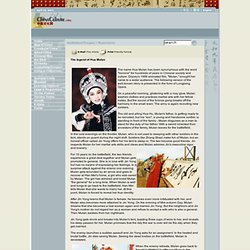
Disney's 1998 animated film, "Mulan," brought her name to a wider audience. The following version of the well-known story is presented in the form of Longjiang Opera. On a peaceful morning, glistening with a rosy glow, Mulan washes clothes and practices martial arts with her fellow mates. What is China's one-child policy?" One-child policy. The one-child policy, officially the family planning policy,[1] is the population control policy of the People's Republic of China.
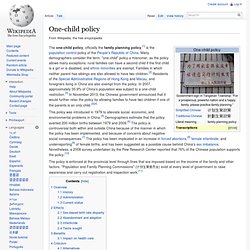
Many demographers consider the term, "one-child" policy a misnomer, as the policy allows many exceptions: rural families can have a second child if the first child is a girl or is disabled, and ethnic minorities are exempt. Families in which neither parent has siblings are also allowed to have two children.[2] Residents of the Special Administrative Regions of Hong Kong and Macau, and foreigners living in China are also exempt from the policy.
In 2007, approximately 35.9% of China's population was subject to a one-child restriction.[3] In November 2013, the Chinese government announced that it would further relax the policy by allowing families to have two children if one of the parents is an only child.[2][4] The Great Wall Of China. Learn a little about the amazing Great Wall of China with your children, and tie in your learning with our activity suggestions, printables and stories.
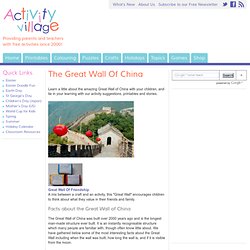
Great Wall Of Friendship A mix between a craft and an activity, this "Great Wall" encourages children to think about what they value in their friends and family. Silk. History of Silk. Traditional Chinese Wedding — Traditional Chinese Weddings. Traditional Chinese wedding customs are considered as the foundation of rites in traditional Chinese culture.
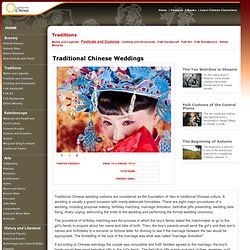
A wedding is usually a grand occasion with overly-elaborate formalities. There are eight major procedures of a wedding, including proposal making, birthday matching, marriage divination, betrothal gifts presenting, wedding date fixing, dowry urging, welcoming the bride to the wedding and performing the formal wedding ceremony. The procedure of birthday matching was the process in which the boy's family asked the matchmaker to go to the girl's family to enquire about her name and date of birth. Then, the boy's parents would send the girl's and their son's names and birthdates to a sorcerer or fortune teller for divining to see if the marriage between the two would be appropriate. Chinese Funeral Customs. Chinese Funeral Customs Since cremation is traditionally uncommon, the burial of the dead is a matter taken very seriously in Chinese society. Improper funeral arrangements can wreak ill fortune and disaster on the family of the deceased.
To a certain degree, Chinese funeral rites and burial customs are determined by the age of the deceased, cause of death, status and position in society, and marital status. According to Chinese custom, an elder should never show respect to someone younger. Chinese Funeral. See how people’s lives are remembered and celebrated at Chinese funerals. Chinese funeral traditions vary depending on where the deceased person and his or her family are from but some basic traditions still apply. How Do Family and Friends Prepare for a Chinese Funeral? The job of coordinating and preparing the Chinese funerals of elders falls on children or younger family members. Chinese Zodiac and Chinese Zodiac Signs. The Chinese Zodiac Calendar. About China — By Brendon on 28/07/2012 9:20 am In China there is a 12 year calendar that is known in the west as the Chinese Zodiac.
This calendar attributes each of the 12 years to an animal so the Chinese Zodiac has 12 animals which are the Rat, Ox, Tiger, Rabbit, Dragon, Snake, Horse, Sheep (Goat), Monkey, Rooster, Dog and Pig. The year you are born in is a big deal in China and a big talking point with many Chinese for casual conversation, dating and marriage, job interviews and much more. The reason being is that each year/animal has different strengths and weaknesses and some animals are more highly regarded than others. What Animal/Zodiac Are You? When you are travelling and living in China, you have to know your birth year so if you don’t already know, check below.
Chinese New Year: 2013. Traditional clothing. Back to History for Kids Clothing in Ancient China was a symbol of status. Top China Travel,Best China Guide. Chinese people were wearing silk while other cultures were still dressing in animal skins. Clothing in China did not only evolve over time; it often transformed dramatically following Dynastic changes or the Imperial decree of a new ruler.
In ancient feudal society, people’s rank and position could easily be distinguished from their daily dress, especially for the ordinary people and upper-class. Acupuncture. Acupuncture has been part of traditional Chinese medicine (TCM) for thousands of years. It involves inserting fine needles into specific points on the skin or applying various other techniques to the acupuncture points to bring about healing.
Acupuncture.